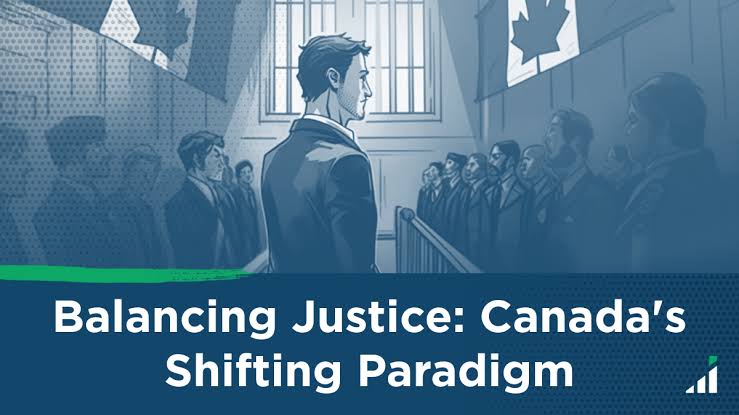Canada’s criminal justice system is undergoing significant reforms aimed at addressing systemic bias, reducing recidivism, enhancing public safety, and modernizing procedures. These changes reflect a broader shift toward more equitable, community‑focused, and rehabilitation‑oriented justice policies.
Strengthening Bail and Pre-Trial Procedures
Effective January 4, 2024, legislation amended the Criminal Code to tighten bail conditions for repeat violent offenders, especially those involving weapons or intimate partner violence. New reverse‑onus provisions place the burden on the accused to prove they are not a flight risk or danger to the public.
Courts are now required to explicitly consider the safety of communities and the unique circumstances of Indigenous or other overrepresented accused when issuing bail decisions. These reforms aim to increase public confidence in pre‑trial decisions while reducing risk.
Addressing Systemic Racism: Indigenous and Black Justice Strategies
Canada is advancing two cornerstone initiatives: the Indigenous Justice Strategy and the Black Justice Strategy. Both are long-term commitments informed by extensive, community‑based consultations.
The Indigenous Justice Strategy includes measures such as Gladue principles, Indigenous courts, and culturally tailored restorative programs to reduce over-incarceration and address colonial legacies.
Parallelly, Canada’s first-ever Black Justice Strategy outlines 114 recommendations to confront systemic anti‑Black racism and reduce disproportionate outcomes for Black individuals in the justice system.
Recidivism Reduction and Community-Based Supports
Since the Federal Framework to Reduce Recidivism (2021–2022) came into force, Canada has prioritized community‑based corrections and re‑integration. Federal funding—including $56 million to the Indigenous Community Corrections Initiative—is supporting culturally informed alternatives to incarceration across provinces beginning in 2025–26.
The government is also investing in restorative justice models—such as virtual support circles for sexual offenders and case‑management programs for senior offenders—to replace cycle‑driven returns to custody.
Sentencing Reform and Ending Mandatory Minimums
New legislation proposes eliminating mandatory minimum penalties (MMPs) for certain offenses—particularly where overrepresentation of Indigenous and Black offenders is evident or where addiction and systemic bias are factors.
Sentencing practices now require Gladue reports and impact assessments to inform decisions that reflect historical and systemic disadvantage. Community Justice Centres pilot projects offer holistic services in places like British Columbia, aiming to reduce reliance on traditional incarceration.
Reforms Affecting Youth Justice
Amendments to the Youth Criminal Justice Act (YCJA) provide clearer criteria for youth detention, limit custodial sentences for minor infractions, and allow adult sentencing only for serious violent offenses by youth aged 14–16 and above.
These changes reduce administrative charges for youth, address over-policing of marginalized youth, and emphasize proportionality in sentencing.
Landmark Court Rulings Shaping Legal Principles
The Supreme Court’s decisions in R v Bissonnette (2022) struck down life sentences without parole as cruel and unusual, reaffirming Charter protections and prompting legislative reflection on parole eligibility policies. Similarly, in R v Brown (2022), Parliament responded after the court found laws barring extreme intoxication as defense violated rights under the charter.
Emerging Public Safety Measures and Enforcement
To counter cross-border organized crime and fentanyl trafficking, Canada has designated seven Latin American criminal groups as terrorist entities under the Criminal Code. This enables seizure of assets and new enforcement powers.
Meanwhile the federal “Strong Borders Act” and provincial initiatives—such as Alberta’s border patrol unit—reflect a more enforcement-driven approach to public safety and border integrity.
Balancing Reform with Public Safety
While many reforms emphasize rehabilitation, diversity, and equity, policymakers have also reinforced tools to address serious crime. Ontario’s Protect Ontario Act grants new powers around involuntary addiction treatment and police authority to tackle trafficking and sex offender control. Critics argue that some enforcement measures risk undermining civil liberties or community trust.
Conclusion
Canada’s criminal justice system is shifting toward a more nuanced, equitable, and community-oriented model. Legislative and policy reforms—spanning bail reform, sentencing, restorative justice, and strategies focused on Indigenous and Black individuals—aim to reduce incarceration, respect systemic context, and advance reconciliation. Simultaneously, public-safety legislation targets violent crime and drug trafficking. The future of Canadian reform lies in balancing accountability with compassion and stabilizing safety with inclusivity.




Interesting